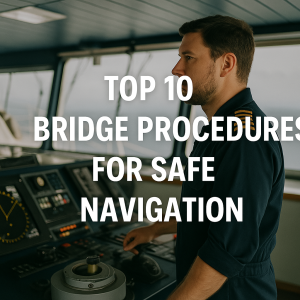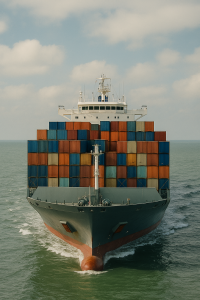Discover the top 10 bridge procedures that ensure safe navigation at sea. This expert guide explores essential protocols, real-world examples, and current best practices for maritime professionals and students.
Why Bridge Procedures Matter in Modern Maritime Operations
Safe navigation is the bedrock of professional seamanship. From colossal container ships to agile offshore support vessels, all rely on standardized bridge procedures to maintain safety, efficiency, and regulatory compliance. In a world where shipping accounts for over 80% of global trade (IMO, 2020), even a minor deviation on the bridge can lead to catastrophic outcomes—groundings, collisions, or environmental disasters.
Standardized bridge procedures serve as a safety net. They eliminate guesswork, reduce human error, and ensure that everyone on the bridge operates with a shared understanding of expectations. Whether you’re a seasoned master or a cadet on your first watch, these procedures are your checklist for accountability, teamwork, and vigilance.
Let’s explore the ten most vital bridge procedures every maritime professional must master—along with the real-world implications of getting them right (or wrong).
1. Passage Planning (Voyage Planning)
Passage planning is the foundation of a safe voyage. According to the International Maritime Organization (IMO Resolution A.893(21)), a passage plan must cover berth-to-berth operations—from the moment a ship leaves port until it arrives at its destination.
Core Steps Include:
-
Appraisal: Collecting charts, weather data, tide tables, Notices to Mariners.
-
Planning: Laying the route using ECDIS and verifying no hazards exist.
-
Execution: Following the plan and monitoring progress in real-time.
-
Monitoring: Adjusting for real-time changes while documenting deviations.
Real-World Example: The grounding of MV Rena in 2011 off New Zealand occurred due to improper voyage planning and lack of situational awareness. It led to major pollution and a $235 million cleanup operation.
2. Bridge Team Management (BTM)
BTM is about communication, leadership, and shared situational awareness. Effective bridge teams operate like orchestras—each role is defined, rehearsed, and responsive.
Core Principles:
-
Clear role assignments
-
Open communication
-
Challenge-and-response culture
-
Continual cross-checking and mutual support
Analogy: Think of BTM like the cockpit of an aircraft. Pilots and co-pilots double-check every decision. Maritime bridges must do the same, especially in high-risk zones like traffic separation schemes or congested approaches.
3. Watchkeeping Standards
The STCW Convention (Section A-VIII/2) outlines mandatory watchkeeping duties. Good watchkeeping practices are crucial for preventing fatigue-related incidents, which account for over 16% of all maritime accidents (UK MAIB, 2021).
Best Practices:
-
Never leave the bridge unattended
-
Perform proper lookout using all available means (visual, radar, AIS)
-
Log entries with accurate time, position, and remarks
Pro Tip: Always record major events like course alterations, weather changes, or sightings of navigational hazards. This log is your best defense in case of incident reviews.
4. Use of Electronic Navigation Aids
Modern ships are tech-heavy, but over-reliance on electronic systems is a double-edged sword. Misuse or misunderstanding of tools like ECDIS and AIS has led to avoidable collisions.
Bridge Best Practices:
-
Always verify ECDIS with paper charts (if applicable)
-
Use radar overlay for anti-collision
-
Validate AIS data with visual confirmation
Case Study: In 2012, the container ship MSC Prestige collided with a tanker due to over-reliance on AIS data. The bridge team didn’t perform proper visual checks or radar tracking.
5. Bridge Equipment Checklist
Before departure or arrival, bridge equipment must be fully operational. SOLAS Chapter V mandates the use and maintenance of navigational systems.
Checklist Includes:
-
Functional gyro and magnetic compass
-
Operational radar and ARPA
-
Verified ECDIS routes
-
Working bridge alarms and engine telegraph
-
Internal and external communication systems
Routine checks foster familiarity with equipment and help detect failures early.
6. Communication Protocols (Internal & External)
Miscommunication is a major root cause of accidents. Standard Marine Communication Phrases (SMCP), as endorsed by the IMO, minimize ambiguity in spoken commands.
Bridge-to-Bridge Tips:
-
Use VHF Channel 16 only for hailing, then switch to a working channel
-
Always confirm receipt of critical orders
-
Avoid colloquialisms; use SMCP terms
Internal Tips:
-
Repeat-back important helm or engine orders
-
Announce changes clearly (“New course 085°, steering now”)
7. Situational Awareness and Lookout
Situational awareness involves understanding what’s happening now and anticipating what might happen next. It’s more than looking out—it’s about integrating information from all sources.
How to Maintain It:
-
Rotate lookouts to avoid fatigue
-
Use radar, AIS, and visual cues together
-
Continually update mental map of surrounding traffic, weather, and hazards
8. Collision Avoidance and Rule Compliance
Every officer must know and apply the International Regulations for Preventing Collisions at Sea (COLREGs). Rule 7 (risk of collision) and Rule 8 (action to avoid collision) are especially critical during close-quarters navigation.
Common Pitfalls:
-
Misjudging other vessels’ intentions
-
Failing to take early and substantial action
-
Ignoring the “give-way” responsibilities
Tip: Always alter course boldly and in ample time. Small, hesitant changes often go unnoticed and increase risk.
9. Emergency Procedures
Bridge teams must be prepared for onboard emergencies—man overboard, fire, loss of propulsion, or navigational blackouts.
Preparedness Includes:
-
Knowing the location and function of all bridge emergency equipment
-
Understanding vessel-specific procedures
-
Drills and scenario-based training
Stat: According to EMSA (2023), vessels with active emergency training records had a 30% lower incident rate.
10. Handover Procedures Between Watchkeepers
Poor handovers can erase hours of good work. The incoming watch must be fully briefed about the vessel’s position, course, traffic, and any pending decisions.
Best Practice:
-
Use a structured handover checklist
-
Brief about known hazards, traffic, equipment status
-
Both watchkeepers must sign off the handover
Real-World Applications: Case Lessons from the Sea
-
Costa Concordia Disaster (2012): Demonstrated the failure of bridge team coordination and failure to follow passage planning.
-
Baltic Dry Collision Incident (2020): Miscommunication on VHF and poor lookout contributed to a collision in restricted waters.
-
Routine Ferry Operations in Scandinavia: High compliance with bridge procedures has led to one of the safest ferry networks in the world.
FAQ: Bridge Procedures & Navigation Safety
Q1: What is the most important bridge procedure?
A: Passage planning is arguably the most critical, as it sets the foundation for the entire voyage.
Q2: How often should the bridge team conduct emergency drills?
A: At least once monthly, but more frequently for high-risk operations or vessels with rapid crew turnover.
Q3: Can ECDIS replace paper charts entirely?
A: Yes, if the system is approved and the crew is trained. However, backup systems and procedures must be in place.
Q4: What’s the biggest cause of bridge-related accidents?
A: Human error—often due to fatigue, miscommunication, or over-reliance on technology.
Q5: Are handover procedures mandatory under STCW?
A: While not itemized in detail, STCW emphasizes the importance of continuity of watch and situational awareness during transitions.
Q6: What’s the role of the OOW in navigation?
A: The OOW (Officer of the Watch) ensures the vessel’s safe navigation, maintains situational awareness, and follows COLREGs.
Q7: How can bridge teams minimize fatigue?
A: Through proper watch rotation, rest hours compliance, and bridge ergonomics (lighting, seating, temperature).
Conclusion
Bridge procedures are not just bureaucratic routines—they are life-saving systems grounded in decades of maritime experience. From planning to execution, from watchkeeping to emergencies, these protocols define the difference between a routine passage and a major incident.
Mariners who internalize and apply these top 10 bridge procedures play a vital role in keeping our seas safe and ships secure. Whether you’re a cadet or captain, these best practices should be your compass for every voyage.
Call to Action: For more insights into maritime safety and career guidance, explore our Maritime Navigation & Safety Hub.
References
-
International Maritime Organization. (2020). Global Maritime Transport Facts and Figures. https://www.imo.org
-
UK MAIB. (2021). Annual Safety Digest. https://www.gov.uk/maib-reports
-
European Maritime Safety Agency (EMSA). (2023). Annual Overview of Marine Casualties. https://emsa.europa.eu
-
IMO Resolution A.893(21). (1999). Guidelines for Voyage Planning. IMO.org




I was suggested this website by my cousin. I’m not
certain whether or not this submit is written by way of him as no one else recognise
such specific approximately my trouble. You’re wonderful!
Thank you!